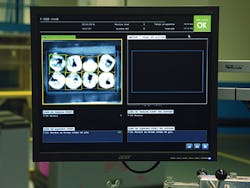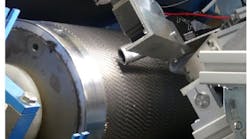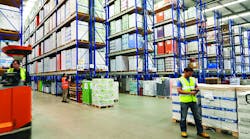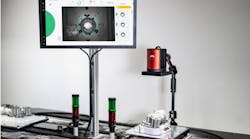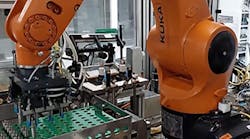At the Health and Beauty facility of Johnson & Johnson (Sézanne, France;www.jnj.com), the company manufactures tampons, nursing pads and adhesive bandages. On one of the packaging lines, tampons fed from a hopper are automatically placed into boxes. Held open by a mechanical guide, the number of tampons placed into each container must be verified before the boxes can be sealed and shipped to the customer.
"Because the tampons are white arranged against a white background and can become slightly compressed, it is difficult to differentiate them by using traditional shape recognition techniques," explains Maxime Bara, Manufacturing Project Manager. Because of this, the company opted to deploy a CV-X vision system from Keyence (Itasca, IL, USA;www.keyence.com) to perform this task.
As the packages move along a production line, they are illuminated by a white LED light that is placed at a 45° angle. "Direct lighting would have made it difficult to obtain images with high enough contrast to distinguish the white tampons against their white background," says Bara.
Images of the top of the carton are then captured by a 5Mpixel 2/3in color CCD camera from Keyence that is interfaced with a proprietary interface to the company's CV-X vision system. To ensure that high-contrast images are captured by the system, the CV-X vision system employs a high-dynamic range (HDR) feature in which multiple images of the boxes are captured at different shutter speeds and then combined.
To count the number of products in each package, operators use the CV-X's teaching function to train the system to recognize approximately thirty non-defective targets. When setting up the system, operators choose from a number of different types of measurements that identify the shape, color and pattern of the contents. Context-sensitive help provides the information needed to highlight areas within the image and the distances between objects, eliminating traditional programming of machine vision algorithms. Objects with these regions are then identified by Keyence's ShapeTrax2 shape detection algorithm. Running on the CV-X, this algorithm is used to recognize the shapes of the tampons and the count number of products recognized regardless of their position.
As untrained cartons are then presented to the system, the system then uses the ShapeTrax algorithm to identify defective packages that do not conform to pre-trained data measurements. Recognizing the similarities between non-defective boxes rather than detect defective target using traditional image processing techniques allows the system to adjust automatically allowable manufacturing tolerances.
After the system is configured, the CV-X automatically generates a user manual for the system, saving the systems developer the time of writing different manuals for each specific inspection task. Should the system detect a badly-packed box or one with insufficient products, the vision system is used to trigger a mechanical actuator that rejects the boxes. According to Bara, it took one day to create five programs required for each of five package types.
